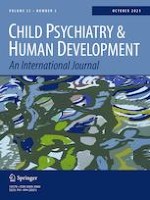20-09-2020 | Original Article
Irritability, Depressed Mood, Inattention and Spatial Working Memory in Children and Adolescents with Major Depressive Disorder With/Without Persistent Depressive Disorder
Gepubliceerd in: Child Psychiatry & Human Development | Uitgave 5/2021
Log in om toegang te krijgenAbstract
The specific relationships between sad/low mood, irritability, inattention and spatial working memory (SWM) have not been systematically examined in young people with major depressive disorder with and without persistent depressive disorder. 313 medication naïve young people (aged 6–16 years) with active major depressive disorder (MDD) alone, persistent depressive disorder (DD) alone and comorbid active MDD and DD were identified. Standard multiple regression was used to investigate how well SWM components—Spatial Span, Strategy and Between Search Errors (BSE)-predict ‘sad/unhappy’, ‘irritable’ mood and ‘Inattention’. Spatial Span (4% of the variance—decreased), Strategy and BSE (both 1% of the variance increased) all made independent significant contributions to ‘Inattention’ while having no independent association with ‘sad/unhappy’ or ‘Irritable’ mood. These findings support the independence of depressive cognitive impairment from the two main components of depressive mood. Improving SWM and attention via targeted management approaches may aid young people with these depressive disorders.
